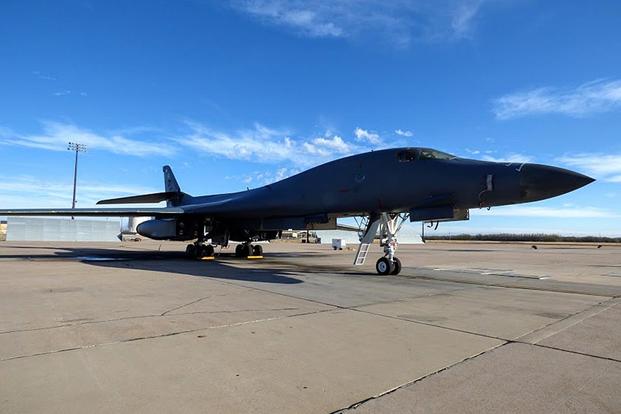DYESS AIR FORCE BASE, Texas -- The Lancers are coming back.
B-1B bomber aircrews anticipate returning to the Middle East in coming months and have been training for the evolving battlespaces in Iraq and Syria, as well as Afghanistan, according to officials here.
"We're working real hard inside of our training network," said Col. Karl Fischbach, commander of the 7th Operations Group. "The ranges that we have were set up really well to simulate the environment, and we're going to attend the next Red Flag [in January] and Green Flag [exercises] in the [upcoming] year, and really focus on what we need to get ready for the CentCom operation."
Military.com sat down with a variety of leaders from Air Force Global Strike Command's 7th Bomb Wing -- responsible for producing combat ready aircrews in the Air Force's only B-1B formal training unit -- during a trip to the base, and took a ride Tuesday in the B-1B over training ranges in New Mexico.
"We've always had a pivotal role in what our Air Force is doing -- Dyess Air Force Base has always been right there," Col. Brandon Parker, 7th Bomb Wing commander, said during a roundtable interview.
Related content:
- START Lanced the B-1's Nukes, But the Bomber Will Still Get New Bombs
- Air Force 'Flexible' on B-1's Return to Fight Against ISIS
- US B-1B Bombers Conduct First Nighttime Drills With Pacific Allies
The non-nuclear-capable aircraft, known as the "Bone," left the Central Command area of responsibility in early 2016, and was replaced by B-52 Stratofortress bombers at Al Udeid Air Base, Qatar, that April.
Officials at the time said the B-1B's return stateside was crucial to upgrade the fleet with the latest Integrated Battle Station, known as the IBS upgrade, which so far has been incorporated into more than half of the 62 total aircraft.
Specifically, the 9th Bomb Squadron here hasn't been back to CentCom since February 2015, according to Lt. Col. Erick Lord, the squadron's commander.
Rotations for the long-range, large payload bomber between the Pacific and Middle East could be fluid: Bomber units from Ellsworth Air Force Base, South Dakota, (currently assigned to Pacific Command) may rotate into the Middle East, while crews from Dyess take over their mission in the Pacific, or vice versa.
It would also mark a significant shift in having a single platform in two theaters, spreading the Lancer fleet during a time when the Air Force finds itself busier than ever.
"Every one squadron, they live to go do what we're going to do even if it means being away from home -- they want to deploy. It's what we do, especially if you're in a fighter or bomber [unit]," Lord said. "We're the smallest Air Force we've ever been, and the demand for airpower continues to increase, and the two don't match."
Officials would not speak to how this changes, or splits the mission, for the B-52 -- capable of carrying nuclear weapons -- going forward.
Prepare for Every Unknown
Even as the air campaign against the Islamic State in Iraq and Syria steadily winds down, it still requires "surgical strikes," or precision-guided bombs on target as the battlespace continues to shrink, said Maj. Charles "Astro" Kilchrist, chief of training for the 9th.
Meanwhile, the U.S. has increased airstrikes in Afghanistan.
Empowered with more independence and authority under the Trump administration, the U.S. military this year has turned to a number of technologies for the war in Afghanistan, from the largest conventional bomb to the F-22 Raptor stealth fighter.
It's also given ground commanders more authority to execute missions beyond self-defense against Taliban fighters.
For B-1 crews, being involved in both Operations Inherent Resolve and Freedom's Sentinel means they prepare for everything and anything, even the unexpected call of a bomb run.
"It's always really difficult to get into the fog and friction of war," Fischbach said. "But our instructors built some pretty varsity scenarios to get our experience level and prep ready to go."
Lord added, "We'll train to the most stringent [rules of engagement] and then we'll develop training scenarios that walk people down the rabbit hole, that force them to make mistakes" so they can be identified before they're made.
"Because busting ROE will get you sent home," he said.
Kilchrist, also a B-1B pilot, said that aside from the experiences acquired at Red Flag -- an integrated, multi-force training game within a simulated combat environment -- and Green Flag -- a coalition exercise consisting of close-air support and air-to-surface training -- programs to get prepped and ready for combat have been upgraded and modified.
"We're tailoring our training to accomplish those things … and we're integrating more than ever with F-16 units out of Fort Worth ... to do mission commander upgrades, with [Joint Terminal Attack Controllers] from all around the country," he said.
"We're really bringing all these things into the fold to increase our aperture for training and give us the best possible simulation of what combat in different theaters are going to be like," Kilchrist said.
That includes the Pacific, he noted, where B-1s took over for the B-52s in 2016, marking the first time the B-1B has been housed at Andersen Air Force Base, Guam, since 2006.
"What my job is to show the new guys, 'Hey, we can go to Afghanistan tomorrow, or we can go to PaCoM tomorrow, but you've got to be ready for both,' " he said.
Parker, speaking broadly to the Bone's mission set, added, "At the end of the day, we got to be able to range targets, and do it in a way that's very lethal. Variety of weapons, different sort of battlespaces ... we're making sure we're ready."
-- Oriana Pawlyk can be reached at oriana.pawlyk@military.com.













